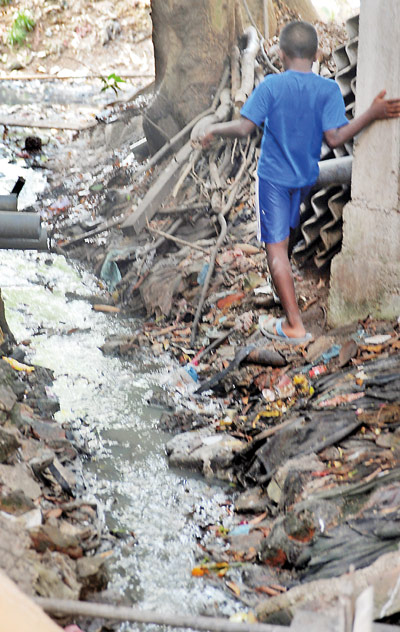News
Poor rubbish collection hatching more dengue menace
 Councils’ failure to collect garbage is worsening the spread of dengue, Central Epidemiological Unit Director Dr. Paba Palihawadana said.
Councils’ failure to collect garbage is worsening the spread of dengue, Central Epidemiological Unit Director Dr. Paba Palihawadana said.
About 4,500 dengue cases and eight deaths were reported in the country since early this month. Colombo has the highest dengue population with major breeding spots being Maligawatta West, Cinnamon Gardens, Kirulapone, Bambalapitiya, Wellampitiya, Modera, Mattakkuliya and Punchi Borella.
This year in the Colombo municipality area, 393 cases were found – slightly higher than last year when 321 cases were reported.
Dr. Palihawadana said unless the authorities take immediate action to rectify the problems in garbage collection and disposal the dengue menace would increase.
She pointed to how people keep garbage in polythene bags hung on gates and fences until they are collected.
“These bags sometimes are not collected for days, making them an ideal breeding spot for mosquitoes,” Dr. Palihawadana said, adding that the public should also take responsibility for this.
Religious places – particularly Buddhist temple grounds – and schools in the Western Province are prime breeding grounds, authorities say.

Breeding ground: A waterway strewn with rubbish
There is 50-50 chance that a school is a dengue-positive spot and a 56 per cent that religious places are dengue breeding sites, the Ministry of Health’s National Coordinator for Dengue, Dr. Hasitha Tissera said.
Last year, 783 individual dengue breeding offenders were fined up to Rs. 2.6 million and action was taken against 300 public institutions.
“We need a strategic dengue management system in hospitals,” Dr Tissera said pointing out that dengue patients are kept in wards in the same way as other patients so that mosquitoes that attack them can take the virus to other patients.
“Patients should be kept inside nets and hospital authorities should ensure that dengue breeding places are removed,” he said.
The Colombo Municipal Council’s Chief Medical Officer, Dr. Ruwan Wijemuni, said Buddhist temples have been found to be major breeding areas for mosquitoes.
The council has initiated comprehensive strategies to tackle the increase of mosquitoes, including those that spread other diseases such as meningitis. The dengue mosquito also carries chikungunya, yellow fever and zika bacillus (see separate story on zika).
“We are also hoping to import a mosquito catcher known as the Mega Catcher where a large number of mosquitoes can be destroyed using a unique system,” Dr. Wijemuni said. Each Mega Catcher would cost the government up to Rs. 300,000.
“This is the dry arid season and mosquitoes breed inside houses in places such as refrigerator trays, vases and other water collecting spots. It is important to clean all these places,” Dr. Wijemuni said.
He said new research by the World Health Organisation showed that mosquitoes carrying dengue not only infect humans with the virus but lay eggs where the larvae carry the virus from birth.
A mosquito can lay up to 100-300 eggs in one sitting and produce 1,000 eggs during its life span. The parent mosquito uses several spots to place its larvae, leaving optimum opportunity for survival.
Dengue mosquitoes came into the country in 1987- 1990 when vehicle tyres were imported to the country from Thailand. With global warming, the dengue population has drastically increased during the past years.
| Anti-mozzie chemicals are harming us The rising mosquito population has led to an equivalent surge in the use of chemicals, posing a new public threat, Colombo Municipal Council (CMC) Chief Medical Officer Dr. Ruwan Wijemuni said. Dr. Wijemuni said eradication was difficult as one mosquito could produce up to 1,000 progeny during its lifetime, with half of them being females that could lead to the population increasing to more than four million in the third generation. “The CMC is spending over Rs. 40 million on chemicals to kill mosquitoes,” the doctor revealed.Residents in and around Colombo City use Rs. 21m worth of mosquito coils a year as well. All these chemicals cause allergic reactions and asthmatic conditions. A mosquito coil seller in Maligawatte, Ganesh David Johnson, said sales of coils have increased, with people buying entire boxes of the product at a time. Last month, he sold 15 large boxes of coils, each containing 60 small packages, and this month he sold 25 boxes. Maligawatte resident Umiar Rahuman said she uses up to two coils daily to keep mosquitoes away. Six-year-old Mohamed Ishan is an example of the prevalence of the disease. The little boy said he did not want to become infected with dengue fever ever again. He has been struck twice by the fever and his parents have now stopped him from playing outside with his friends, fearing he would fall victim again. |

